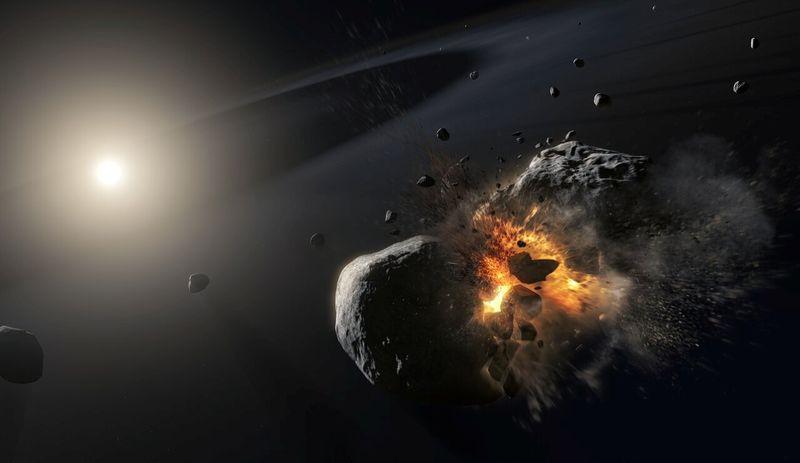
Scientists have observed what appears to be the aftermath of a violent collision between two planetary building blocks orbiting a large and luminous star, a glimpse of the type of carnage that may have been commonplace early in our solar system's history.
 |
|
Artist's Impression of a collision of two icy asteroid-sized bodies orbiting the bright star Fomalhaut, about 25 light-years from Earth. |
Scientists have observed what appears to be the aftermath of a violent collision between two planetary building blocks orbiting a large and luminous star, a glimpse of the type of carnage that may have been commonplace early in our solar system’s history.
The apparent crash between two icy bodies each about 125 miles (200 km) wide occurred around a star called Fomalhaut, located a relatively close 25 light-years from Earth, that is about twice the mass and 17 times the luminosity of the sun, the researchers said. A light year is the distance light travels in a year, 5.9 trillion miles (9.5 trillion km).
The two parties in this celestial smash-up may have been objects called planetesimals that are thought to join together to eventually form planets during a planetary system’s formative stages though in this case the two were destroyed.
“We have never witnessed a collision of this scale anywhere, and we know that collisional activity in the early solar system was vital in shaping it,” said astronomer András Gáspár of the University of Arizona’s Steward Observatory, lead author of the research published this week in the journal Proceedings of the National Academy of Sciences.
“The Earth-Moon system formed in a violent collision, though not in one that destroyed both bodies. We would not be here to talk about this system if it weren’t for a large-scale collision in the history of the early solar system,” Gáspár added.
The two objects were substantially smaller than Earth’s moon but larger than the two small moons of Mars, Phobos and Deimos.
The conclusions about the collision were based on Hubble Space Telescope data collected between 2004 and 2014. Scientists initially believed they had spotted an intact planet and it was announced in 2008 as Hubble’s first image of a planet orbiting another star.
But there were oddities in the data showing that the object grew in size, then faded and ultimately vanished. Researchers concluded what Hubble had observed actually was the immediate aftermath of a collision, with an expanding debris cloud that scattered its pieces into space so it no longer could be detected.
Fomalhaut is one of the brightest stars in the sky, located in the constellation Pisces Austrinus, the Southern Fish. It was already known Fomalhaut was surrounded by icy and dusty disks of debris.
“We know collisions happen in the Fomalhaut system, as its massive debris belt is collisionally maintained,” Gáspár said.
More than 4,000 planets orbiting other stars have been discovered while a crash like this had never been observed. Gáspár said it is a “big deal” to have seen it and that it is good to be “at the right place at the right time.”
(Source: Reuters)





